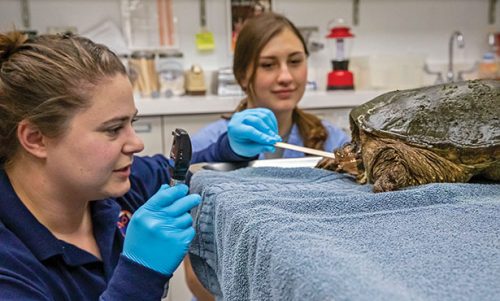Wildlife Rehab – What Can You Do?
It’s an all-too-familiar scenario: A client walks into your clinic with a wild animal. “I found this on the side of the road. Can you do anything?”
Responses can range from excitement to terror to concern over the liability or cost of treating this animal. What can you do?
The answer: A lot, if you are comfortable.
Under a Good Samaritan law or clause (federal and state level), you can house a wild animal up to 24 hours before transferring it to a licensed wildlife rehabilitator. During this time, you can provide any necessary care, up to and including euthanasia.
As most wildlife rehabilitation is non-profit, the cost of this initial care (if not working at the request of a rehabilitator) would fall to you or your clinic, within reason; finders should not be held accountable for costs associated with these animals. Basic triage and stabilization—analgesia, heat support, oxygen supplementation, etc.—and not advanced care are warranted. The Veterinarian’s Oath commits us to “the prevention and relief of animal suffering.” Because these animals do not have owners, you are one of their best advocates.
Different species have different release criteria, or standards that need to be met prior to release. Wild animals need to be able to hunt or forage for food, evade predators, and limit their interactions with humans, so the standard for “return to function” is much higher for them than for domestic species.
Generally speaking, euthanasia should be considered in the following cases: habituation to humans, fracture at a joint that limits ambulation or flight, amputation of a wing, evisceration, severe bilateral ocular trauma in all species, or severe unilateral ocular trauma is species that are dependent on sight. (An owl is an example of a species that tolerates unilateral trauma because owls hunt primarily via the sense of hearing.)
More subtle consideration also needs to be given to native vs. invasive species, migratory status, time of year, age of animal, and so on. However, these decisions do not necessarily need to be made on intake. If release criteria are not met, euthanasia needs to be considered. When in doubt, if pain and suffering can be minimized, contact your closest rehabilitators or wildlife clinic for input. Wildlife species have an amazing capacity for healing.
Every year the Illinois Department of Natural Resources updates a list of state rehabilitators’ names, locations, contact information, and the classes of animals they are permitted to care for. Every rehabilitator needs a veterinarian on record during their license application process, so you may be able to provide not only triage care but day-to-day medical care for individuals/facilities in your area. It’s a good idea to become familiar with rehabilitators listed for your area.
So why even bother? Nature is cruel sometimes, and isn’t it better to let “nature take its course”? Considering most reasons wild animals present in need of medical care are anthropogenic (either directly or indirectly), it could be reasoned that it is our duty to intervene. No wild species has yet to evolve with the ability to recognize and avoid roadways, windows, and even domestic dogs and cats, so the need for care and rehabilitation will be present as long as we share their environment.
Helpful Resources
University of Illinois Wildlife Medical Clinic | vetmed.illinois.edu/wildlife/
Accepts all native Illinois species (except rabies vector species) 365 days a year
217-244-1195
National Wildlife Rehabilitators Association | nwrawildlife.org
Annual national conference for rehabilitators and veterinary professionals; wildlife medicine courses; publications
International Wildlife Rehabilitation Council | theiwrc.org
Training opportunities (in-person and online) and certification; information on species-specific rescue and rehabilitation
By Sarah Reich, DVM




